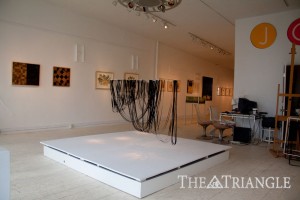Among the artists chosen were Ward Schumaker, Leslie Avon Miller, Jose Camacho, Dennis Parlante, Laura Moriarty, Astrid Fitzgerald, Susan Maguire, Deborah Barlow, spencer + imler, MP Landis, Janet Filomeno and David Meyer.
Walking through the show, you first come to Schumaker’s pieces, “The Euphrates” and “The Alps.” “The Euphrates” first brought to mind a river. So, perhaps influenced by its title, I saw in this piece a body of water, interrupted by land — the land seeming harsher than the water. Next to The Euphrates was “The Alps.” This piece was harder to make out. I didn’t see a mountain, as I was expecting from the title, but what I did immediately see was the imprint or outline of the word CLASS in capital letters clearly spread above smaller letters that spelled out the name of the piece. From this I wondered if the artist was making some statement about class being taller than the peak of a mountain, or was he arranging words to simply translate terms visually to send the audience the phrase “upper class?”
“I refrain from making statements about my work because the work is visual, and I feel it cannot be explained well with words,” Schumaker said. “It’s all about seeing and looking.”
Miller painted the next four pieces. Her simple gray, black and white collages worked well as a set. “The compulsion for creating collage comes from experiencing life as beautifully wild, poignant, and fleeting,” Miller said about her work. “The process of creating collage clears space and light for experiencing the moments.” I could see this set in a stylish apartment or hotel. Her work is very functional with design as wall art that would complement the space but not overwhelm it.
Parlante used collage in his three pieces “Inland,” “Three,” and “27061.” He uses mostly shades of brown and works with his material’s natural colors, or enhances these natural colors.
Moriarty also used collage and a map theme and uses a map as her material to create the figure of a flower for both of her pieces in this show.
Fitzgerald has a total of five pieces in the show. Her work is detailed with symbols from ancient Egypt, and the patterns he uses are reminiscent of a chess board. I can’t help but think of royalty and ancient games and wars when I look at her pieces, “No. 302” and “No. 300.”
Maguire uses sculpture to express imagery within her work, and she said that they are “as characters on a stage that evolve and begin to form a visual language.” “The Audience” is a piece that is constructed as a box with two screens — one front and one back. The screens are translucent, covered with butterflies on the front screen and a picture of a gentleman from the 1800s on the back. Filling the box are transparent plastic rods. Her second piece, “Dethroned,” is perplexing. It looks like an old gadget, but the use for it is not immediately clear. “Foolosophy” is constructed like “The Audience” as the artwork is presented in a thin box with a picture of a court jester on one side of the transparent material and a picture of a heart and spiral on the other.
Barlow’s three pieces drew up different images from the texture of each. Her first piece, “Melk,” reminded me of pictures taken from underwater when the sun shines above the surface. Her second piece, “Yestanta,” uses the same colors but a different texture. This reminds me of stone or rock. The last piece, “Tintinya,” used the same colors, but the texture here was glassy, smooth, reminding me of a gem. “Experimenting with new and unexpected materials is compelling to me because it makes me feel like an alchemist,” Barlow said.
Spencer + imler’s work is collaborative. They are a husband-and-wife team that combines paint, drawing and photography to create one image. Their pieces are linear and reminiscent of a blueprint design, with clips of photographs popping color to create depth. imler
Filomeno captured emotion in “Revisiting Blue Crystals.” This one piece is made up of 9 individual works. Another singular piece that was made out of several smaller works was MP Landis’ “Warehouse Drawing Series” made up of several paintings that resemble a series of pictures strung together to tell a story.
Last, but not least (in fact this piece of work was the largest in the room), I viewed Meyer’s piece, “Air into Breath.” From every angle, the piece looked like air. The sculpture is a hanging installation that allows air in the room to move strings of material tied to metal work. This material captures the air’s movement, and from every perspective you see live art. That is, art that is working in the moment along with elements of nature that also allow for life itself to exist. Without the air, this piece wouldn’t be.
Physical Graffiti’s exhibit opened Sept. 10 and will be running through Oct. 22. The gallery is located on the 4th floor of 723 Chestnut St. For hours of operation and information on present and future exhibits, visit www.jamesolivergallery.com.



